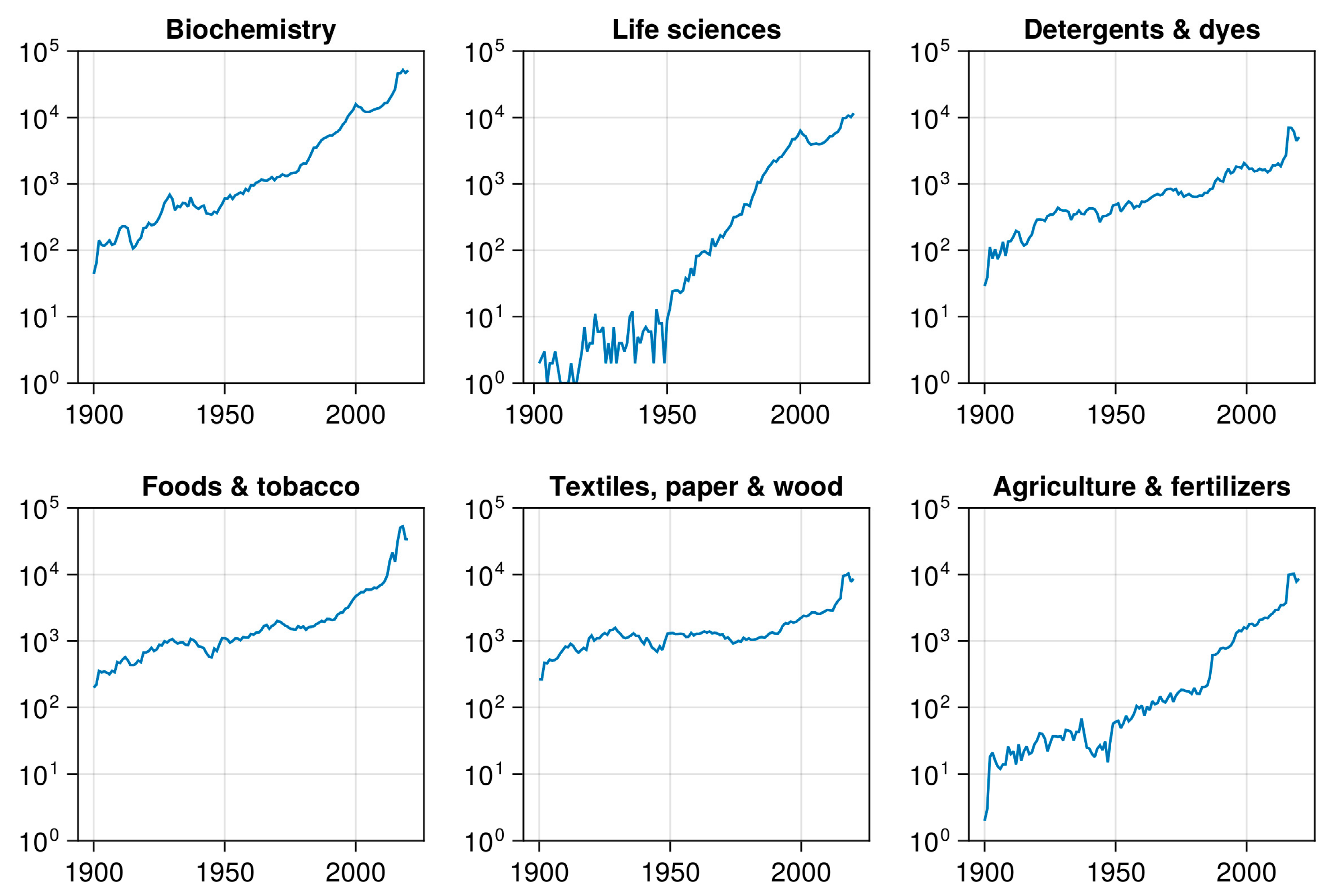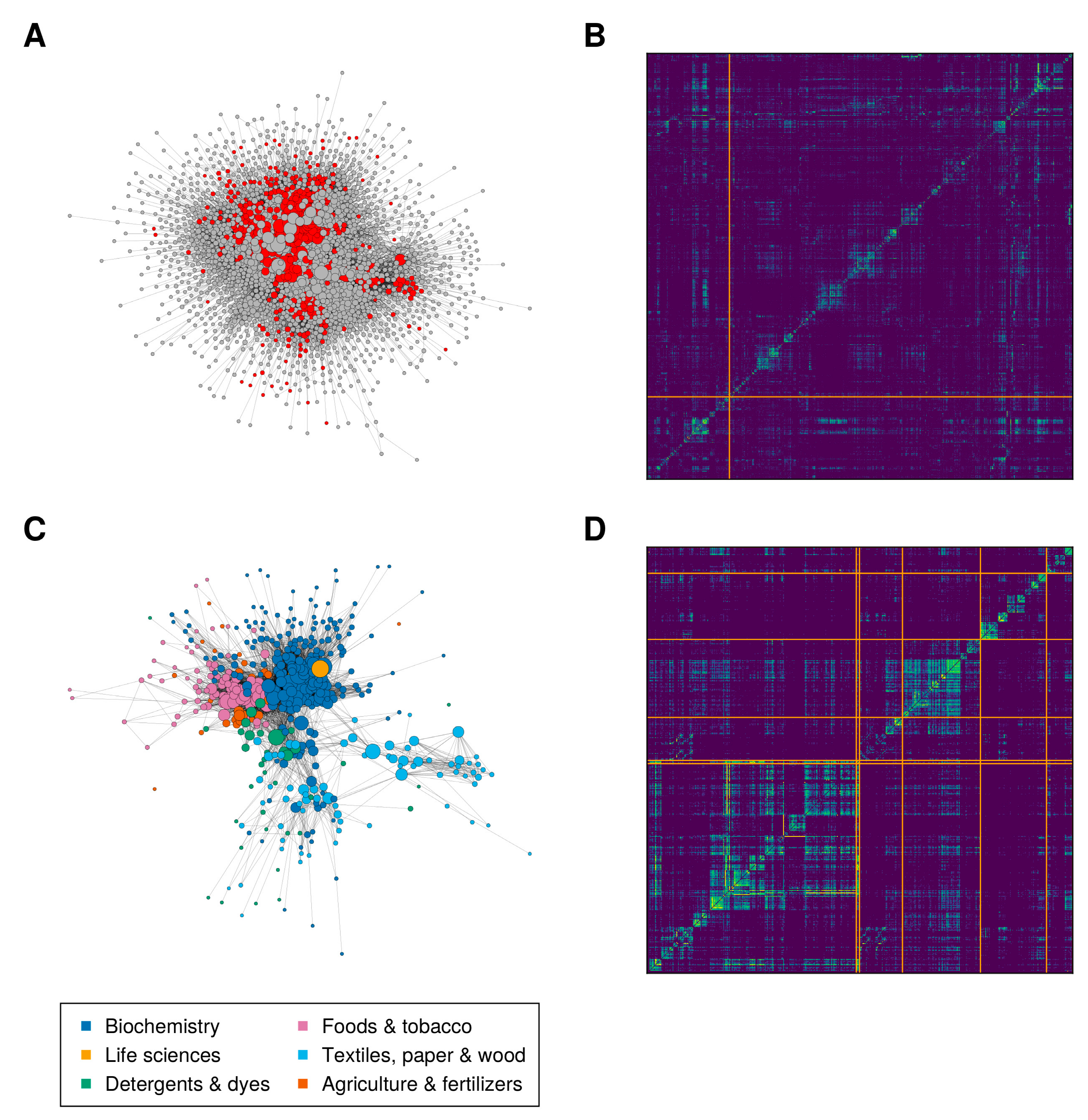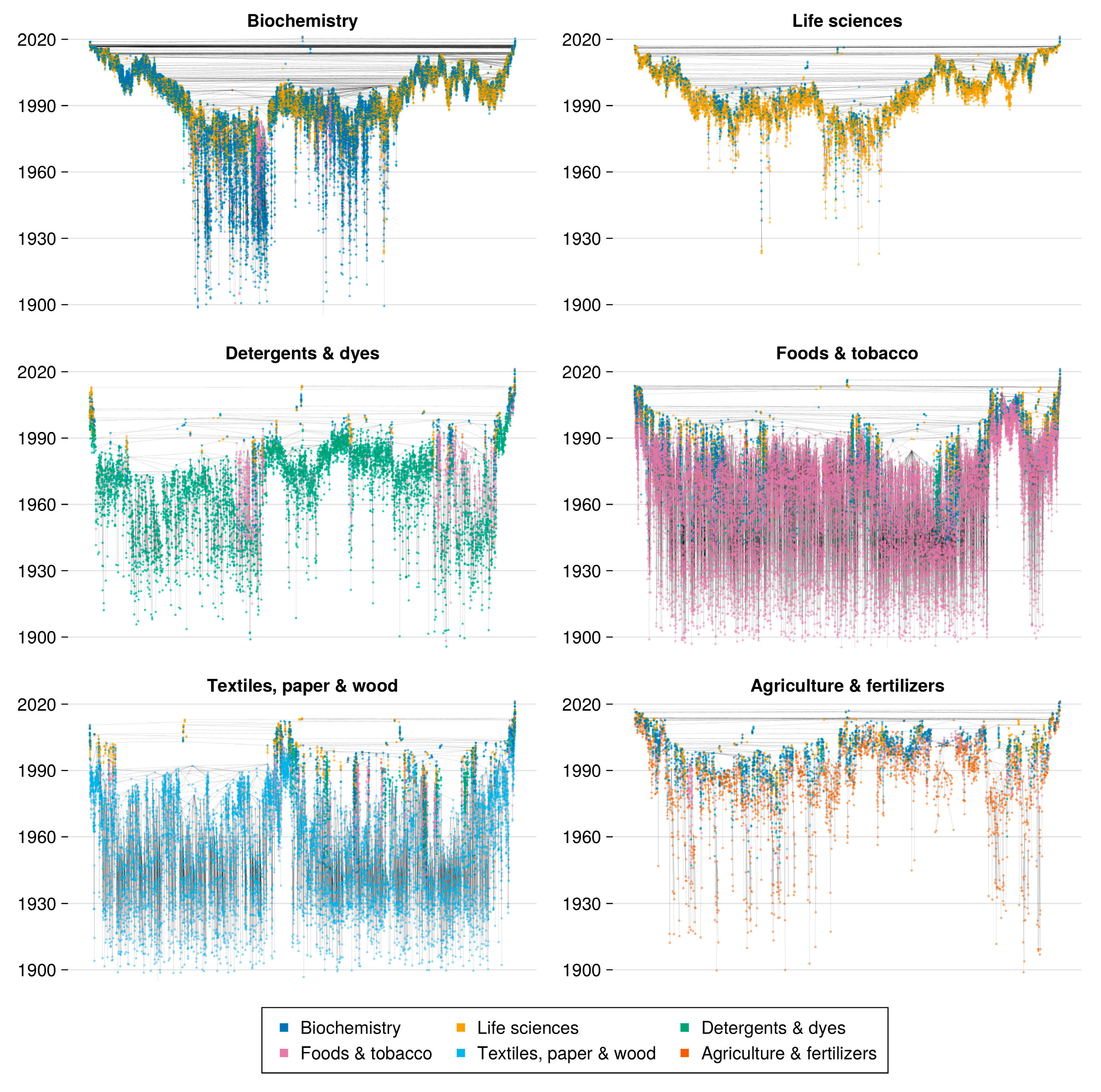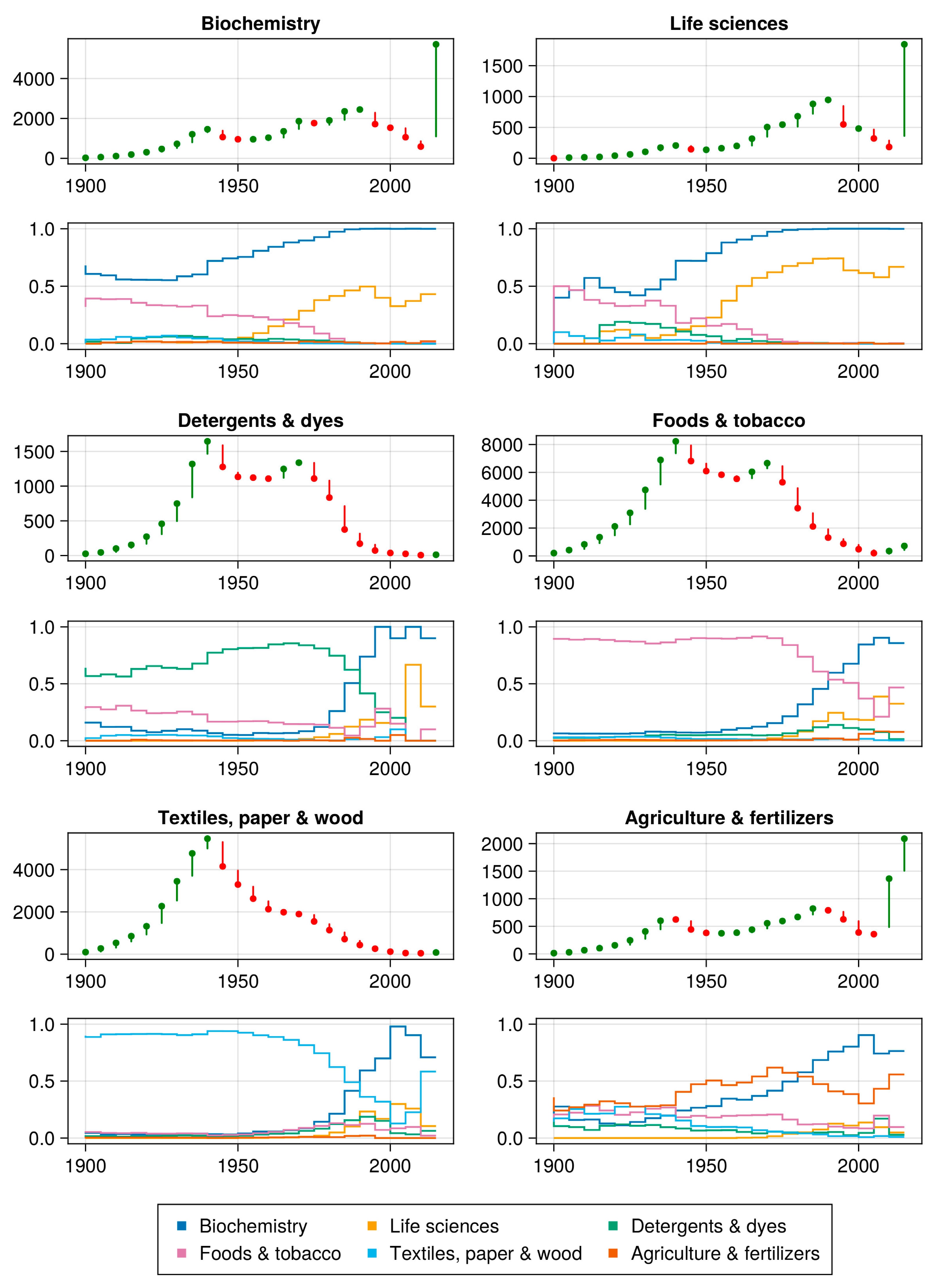Technological Cohesion and Convergence: A Main Path Analysis of the Bioeconomy, 1900–2020
Abstract
1. Introduction
2. Evolution of Heterogeneous Technological Fields
2.1. From Technological Trajectories to Technological Fields
2.2. Processes of Technological Field Evolution
2.3. The Bioeconomy Technological Field and Its Subdomains
3. Data and Methods
3.1. Mapping the Bioeconomy with Patent Data
3.2. Co-Classification and Patent Citations
3.3. Measuring Convergence Based on Main Path Networks
4. Results
4.1. Internal and External Cohesion of the Bioeconomy Technological Field
4.2. Intra- and Inter-Domain Convergence of Main Paths
5. Discussion and Conclusions
Author Contributions
Funding
Institutional Review Board Statement
Informed Consent Statement
Data Availability Statement
Conflicts of Interest
References
- European Commission Target Investment Areas. Available online: https://commission.europa.eu/strategy-and-policy/eu-budget/strategic-technologies-europe-platform/target-investment-areas_en (accessed on 30 June 2023).
- Dosi, G.; Nelson, R.R. Technical Change and Industrial Dynamics as Evolutionary Processes. In Handbook of the Economics of Innovation; Hall, B.H., Rosenberg, N., Eds.; Elsevier: Amsterdam, The Netherlands, 2010; Volume 1, pp. 51–127. [Google Scholar]
- Hargadon, A.; Sutton, R.I. Technology Brokering and Innovation in a Product Development Firm. Adm. Sci. Q. 1997, 42, 716–749. [Google Scholar] [CrossRef]
- Mazzucato, M.; Dosi, G. Knowledge Accumulation and Industry Evolution: The Case of Pharma-Biotech; Cambridge University Press: Cambridge, UK, 2006; ISBN 978-0-521-85822-9. [Google Scholar]
- Strumsky, D.; Lobo, J. Identifying the Sources of Technological Novelty in the Process of Invention. Res. Policy 2015, 44, 1445–1461. [Google Scholar] [CrossRef]
- McCormick, K.; Kautto, N. The Bioeconomy in Europe: An Overview. Sustainability 2013, 5, 2589–2608. [Google Scholar] [CrossRef]
- Staffas, L.; Gustavsson, M.; McCormick, K. Strategies and Policies for the Bioeconomy and Bio-Based Economy: An Analysis of Official National Approaches. Sustainability 2013, 5, 2751–2769. [Google Scholar] [CrossRef]
- Buchholz, K.; Collins, J. The Roots—A Short History of Industrial Microbiology and Biotechnology. Appl. Microbiol. Biotechnol. 2013, 97, 3747–3762. [Google Scholar] [CrossRef]
- D’Adamo, I.; Gastaldi, M.; Morone, P.; Rosa, P.; Sassanelli, C.; Settembre-Blundo, D.; Shen, Y. Bioeconomy of Sustainability: Drivers, Opportunities and Policy Implications. Sustainability 2022, 14, 200. [Google Scholar] [CrossRef]
- Dosi, G. Technological Paradigms and Technological Trajectories. A Suggested Interpretation of the Determinants and Directions of Technical Change. Res. Policy 1982, 11, 147–162. [Google Scholar] [CrossRef]
- Epicoco, M. Knowledge Patterns and Sources of Leadership: Mapping the Semiconductor Miniaturization Trajectory. Res. Policy 2013, 42, 180–195. [Google Scholar] [CrossRef][Green Version]
- Martinelli, A. An Emerging Paradigm or Just Another Trajectory? Understanding the Nature of Technological Changes Using Engineering Heuristics in the Telecommunications Switching Industry. Res. Policy 2012, 41, 414–429. [Google Scholar] [CrossRef]
- Aaldering, L.J.; Song, C.H. Tracing the Technological Development Trajectory in Post-Lithium-Ion Battery Technologies: A Patent-Based Approach. J. Clean. Prod. 2019, 241, 118343. [Google Scholar] [CrossRef]
- Huenteler, J.; Ossenbrink, J.; Schmidt, T.S.; Hoffmann, V.H. How a Product’s Design Hierarchy Shapes the Evolution of Technological Knowledge—Evidence from Patent-Citation Networks in Wind Power. Res. Policy 2016, 45, 1195–1217. [Google Scholar] [CrossRef]
- Verspagen, B. Mapping Technological Trajectories as Patent Citation Networks: A Study on the History of Fuel Cell Research. Adv. Complex Syst. 2007, 10, 93–115. [Google Scholar] [CrossRef]
- Powell, W.W.; White, D.R.; Koput, K.W.; Owen-Smith, J. Network Dynamics and Field Evolution: The Growth of Interorganizational Collaboration in the Life Sciences. Am. J. Sociol. 2005, 110, 1132–1205. [Google Scholar] [CrossRef]
- Bioeconomy Council Sustainable Bioeconomy. Available online: https://www.biooekonomierat.de/en/bioeconomy-council/sustainable-bioeconomy.php (accessed on 1 July 2023).
- El-Chichakli, B.; von Braun, J.; Lang, C.; Barben, D.; Philp, J. Policy: Five Cornerstones of a Global Bioeconomy. Nature 2016, 535, 221–223. [Google Scholar] [CrossRef] [PubMed]
- OECD. The Bioeconomy to 2030: Designing a Policy Agenda; Organization for Economic Co-Operation and Development: Paris, France, 2009; ISBN 978-92-64-03853-0. [Google Scholar]
- Kaplan, S.; Vakili, K. The Double-Edged Sword of Recombination in Breakthrough Innovation. Strateg. Manag. J. 2015, 36, 1435–1457. [Google Scholar] [CrossRef]
- Frenken, K.; Izquierdo, L.R.; Zeppini, P. Branching Innovation, Recombinant Innovation, and Endogenous Technological Transitions. Environ. Innov. Soc. Transit. 2012, 4, 25–35. [Google Scholar] [CrossRef]
- Kodama, F. Harvard Business Review; Elsevier: Amsterdam, The Netherlands, 1992. [Google Scholar]
- Curran, C.-S.; Bröring, S.; Leker, J. Anticipating Converging Industries Using Publicly Available Data. Technol. Forecast. Soc. Change 2010, 77, 385–395. [Google Scholar] [CrossRef]
- Sick, N.; Preschitschek, N.; Leker, J.; Bröring, S. A New Framework to Assess Industry Convergence in High Technology Environments. Technovation 2019, 84–85, 48–58. [Google Scholar] [CrossRef]
- Jeong, S.; Kim, J.-C.; Choi, J.Y. Technology Convergence: What Developmental Stage Are We In? Scientometrics 2015, 104, 841–871. [Google Scholar] [CrossRef]
- Gauch, S.; Blind, K. Technological Convergence and the Absorptive Capacity of Standardisation. Technol. Forecast. Soc. Change 2015, 91, 236–249. [Google Scholar] [CrossRef]
- Han, E.J.; Sohn, S.Y. Technological Convergence in Standards for Information and Communication Technologies. Technol. Forecast. Soc. Change 2016, 106, 1–10. [Google Scholar] [CrossRef]
- Bröring, S.; Leker, J. Industry Convergence and Its Implications for the Front End of Innovation: A Problem of Absorptive Capacity. Creat. Innov. Manag. 2007, 16, 165–175. [Google Scholar] [CrossRef]
- Caviggioli, F. Technology Fusion: Identification and Analysis of the Drivers of Technology Convergence Using Patent Data. Technovation 2016, 55–56, 22–32. [Google Scholar] [CrossRef]
- Curran, C.-S.; Leker, J. Patent Indicators for Monitoring Convergence—Examples from NFF and ICT. Technol. Forecast. Soc. Change 2011, 78, 256–273. [Google Scholar] [CrossRef]
- Gambardella, A.; Torrisi, S. Does Technological Convergence Imply Convergence in Markets? Evidence from the Electronics Industry. Res. Policy 1998, 27, 445–463. [Google Scholar] [CrossRef]
- Duysters, G.; Hagedoorn, J. Technological Convergence in the IT Industry: The Role of Strategic Technology Alliances and Technological Competencies. Int. J. Econ. Bus. 1998, 5, 355–368. [Google Scholar] [CrossRef]
- Jung, S.; Kim, K.; Lee, C. The Nature of ICT in Technology Convergence: A Knowledge-Based Network Analysis. PLoS ONE 2021, 16, e0254424. [Google Scholar] [CrossRef] [PubMed]
- No, H.J.; Park, Y. Trajectory Patterns of Technology Fusion: Trend Analysis and Taxonomical Grouping in Nanobiotechnology. Technol. Forecast. Soc. Change 2010, 77, 63–75. [Google Scholar] [CrossRef]
- Feng, S.; An, H.; Li, H.; Qi, Y.; Wang, Z.; Guan, Q.; Li, Y.; Qi, Y. The Technology Convergence of Electric Vehicles: Exploring Promising and Potential Technology Convergence Relationships and Topics. J. Clean. Prod. 2020, 260, 120992. [Google Scholar] [CrossRef]
- Kose, T.; Sakata, I. Identifying Technology Convergence in the Field of Robotics Research. Technol. Forecast. Soc. Change 2019, 146, 751–766. [Google Scholar] [CrossRef]
- Kim, E.; Cho, Y.; Kim, W. Dynamic Patterns of Technological Convergence in Printed Electronics Technologies: Patent Citation Network. Scientometrics 2014, 98, 975–998. [Google Scholar] [CrossRef]
- Sanz-Hernández, A.; Esteban, E.; Garrido, P. Transition to a Bioeconomy: Perspectives from Social Sciences. J. Clean. Prod. 2019, 224, 107–119. [Google Scholar] [CrossRef]
- Giampietro, M. On the Circular Bioeconomy and Decoupling: Implications for Sustainable Growth. Ecol. Econ. 2019, 162, 143–156. [Google Scholar] [CrossRef]
- Kakadellis, S.; Rosetto, G. Achieving a Circular Bioeconomy for Plastics. Science 2021, 373, 49–50. [Google Scholar] [CrossRef]
- Muscat, A.; de Olde, E.M.; Ripoll-Bosch, R.; Van Zanten, H.H.E.; Metze, T.A.P.; Termeer, C.J.A.M.; van Ittersum, M.K.; de Boer, I.J.M. Principles, Drivers and Opportunities of a Circular Bioeconomy. Nat. Food 2021, 2, 561–566. [Google Scholar] [CrossRef] [PubMed]
- Lewandowski, I. (Ed.) Bioeconomy: Shaping the Transition to a Sustainable, Biobased Economy; Springer International Publishing: Cham, Switzerland, 2018; ISBN 978-3-319-68151-1. [Google Scholar]
- Bahaji, A.; Li, J.; Sánchez-López, Á.M.; Baroja-Fernández, E.; Muñoz, F.J.; Ovecka, M.; Almagro, G.; Montero, M.; Ezquer, I.; Etxeberria, E.; et al. Starch Biosynthesis, Its Regulation and Biotechnological Approaches to Improve Crop Yields. Biotechnol. Adv. 2014, 32, 87–106. [Google Scholar] [CrossRef] [PubMed]
- Bailey-Serres, J.; Parker, J.E.; Ainsworth, E.A.; Oldroyd, G.E.D.; Schroeder, J.I. Genetic Strategies for Improving Crop Yields. Nature 2019, 575, 109–118. [Google Scholar] [CrossRef]
- Sharma, H.C.; Crouch, J.H.; Sharma, K.K.; Seetharama, N.; Hash, C.T. Applications of Biotechnology for Crop Improvement: Prospects and Constraints. Plant Sci. 2002, 163, 381–395. [Google Scholar] [CrossRef]
- Jiao, G.-J.; Peng, P.; Sun, S.-L.; Geng, Z.-C.; She, D. Amination of Biorefinery Technical Lignin by Mannich Reaction for Preparing Highly Efficient Nitrogen Fertilizer. Int. J. Biol. Macromol. 2019, 127, 544–554. [Google Scholar] [CrossRef]
- Santamaría-Fernández, M.; Molinuevo-Salces, B.; Lübeck, M.; Uellendahl, H. Biogas Potential of Green Biomass after Protein Extraction in an Organic Biorefinery Concept for Feed, Fuel and Fertilizer Production. Renew. Energy 2018, 129, 769–775. [Google Scholar] [CrossRef]
- Kallio, A.M.I. Wood-Based Textile Fibre Market as Part of the Global Forest-Based Bioeconomy. For. Policy Econ. 2021, 123, 102364. [Google Scholar] [CrossRef]
- Morland, C.; Schier, F. Modelling Bioeconomy Scenario Pathways for the Forest Products Markets with Emerging Lignocellulosic Products. Sustainability 2020, 12, 10540. [Google Scholar] [CrossRef]
- Rajesh Banu, J.; Preethi; Kavitha, S.; Tyagi, V.K.; Gunasekaran, M.; Karthikeyan, O.P.; Kumar, G. Lignocellulosic Biomass Based Biorefinery: A Successful Platform towards Circular Bioeconomy. Fuel 2021, 302, 121086. [Google Scholar] [CrossRef]
- Esposti, M.D.; Morselli, D.; Fava, F.; Bertin, L.; Cavani, F.; Viaggi, D.; Fabbri, P. The Role of Biotechnology in the Transition from Plastics to Bioplastics: An Opportunity to Reconnect Global Growth with Sustainability. FEBS Open Bio 2021, 11, 967–983. [Google Scholar] [CrossRef] [PubMed]
- Rosenboom, J.-G.; Langer, R.; Traverso, G. Bioplastics for a Circular Economy. Nat. Rev. Mater. 2022, 7, 117–137. [Google Scholar] [CrossRef] [PubMed]
- Barbosa, J.; Teixeira, P. Biotechnology Approaches in Food Preservation and Food Safety. Foods 2022, 11, 1391. [Google Scholar] [CrossRef] [PubMed]
- Shetty, K. (Ed.) Food Biotechnology, 2nd ed.; CRC Press: Boca Raton, FL, USA, 2006; ISBN 978-0-8247-5329-0. [Google Scholar]
- Hertel, T.; Steinbuks, J.; Baldos, U. Competition for Land in the Global Bioeconomy. Agric. Econ. 2013, 44, 129–138. [Google Scholar] [CrossRef]
- Lewandowski, I. Securing a Sustainable Biomass Supply in a Growing Bioeconomy. Glob. Food Secur. 2015, 6, 34–42. [Google Scholar] [CrossRef]
- Rosegrant, M.W.; Ringler, C.; Zhu, T.; Tokgoz, S.; Bhandary, P. Water and Food in the Bioeconomy: Challenges and Opportunities for Development. Agric. Econ. 2013, 44, 139–150. [Google Scholar] [CrossRef]
- Golembiewski, B.; Sick, N.; Bröring, S. Patterns of Convergence within the Emerging Bioeconomy—The Case of the Agricultural and Energy Sector. Int. J. Innov. Technol. Manag. 2015, 12, 1550012. [Google Scholar] [CrossRef]
- Zilberman, D.; Kim, E.; Kirschner, S.; Kaplan, S.; Reeves, J. Technology and the Future Bioeconomy. Agric. Econ. 2013, 44, 95–102. [Google Scholar] [CrossRef]
- Gupta, R.; Beg, Q.; Lorenz, P. Bacterial Alkaline Proteases: Molecular Approaches and Industrial Applications. Appl. Microbiol. Biotechnol. 2002, 59, 15–32. [Google Scholar] [CrossRef] [PubMed]
- Paul, T.; Das, A.; Mandal, A.; Halder, S.K.; Jana, A.; Maity, C.; DasMohapatra, P.K.; Pati, B.R.; Mondal, K.C. An Efficient Cloth Cleaning Properties of a Crude Keratinase Combined with Detergent: Towards Industrial Viewpoint. J. Clean. Prod. 2014, 66, 672–684. [Google Scholar] [CrossRef]
- Muttenthaler, M.; King, G.F.; Adams, D.J.; Alewood, P.F. Trends in Peptide Drug Discovery. Nat. Rev. Drug Discov. 2021, 20, 309–325. [Google Scholar] [CrossRef] [PubMed]
- Evans, W.E.; Relling, M.V. Moving towards Individualized Medicine with Pharmacogenomics. Nature 2004, 429, 464–468. [Google Scholar] [CrossRef]
- Dunbar, C.E.; High, K.A.; Joung, J.K.; Kohn, D.B.; Ozawa, K.; Sadelain, M. Gene Therapy Comes of Age. Science 2018, 359, eaan4672. [Google Scholar] [CrossRef]
- Wackerbauer, J.; Rave, T.; Dammer, L.; Piotrowski, S.; Jander, W.; Grundmann, P.; Wydra, S.; Schmoch, U. Ermittlung Wirtschaftlicher Kennzahlen Und Indikatoren Für Ein Monitoring Des Voranschreitens Der Bioökonomie; Ifo Institut: München, Germany, 2019. [Google Scholar]
- Jaffe, A.B.; Trajtenberg, M.; Henderson, R. Geographic Localization of Knowledge Spillovers as Evidenced by Patent Citations. Q. J. Econ. 1993, 108, 577–598. [Google Scholar] [CrossRef]
- Hummon, N.P.; Doreian, P. Connectivity in a Citation Network: The Development of DNA Theory. Soc. Netw. 1989, 11, 39–63. [Google Scholar] [CrossRef]
- Liu, J.S.; Lu, L.Y.Y.; Ho, M.H.C. A Few Notes on Main Path Analysis. Scientometrics 2019, 119, 379–391. [Google Scholar] [CrossRef]
- Batagelj, V. Efficient Algorithms for Citation Network Analysis. arXiv 2003, arXiv:cs/0309023v1. [Google Scholar]
- Govender, T.; Naicker, T. Insulin as a Catalyst to Recombinant DNA Technology. Nat. Catal. 2023, 6, 454–455. [Google Scholar] [CrossRef]
- Freeman, C. The Economics of Technical Change. Camb. J. Econ. 1994, 18, 463–514. [Google Scholar] [CrossRef]






| IPC Technology Class | Description |
|---|---|
| Agriculture, foods | |
| A01H | New plants |
| A01P | Chemical agents for the regulation of plant growth |
| A21D | Conservation of flour and dough for baking |
| A23 (excluding A23N, A23P) | Foods |
| A24B | Tobacco |
| A43B,C | Shoewear |
| C05F | Organic fertilizer |
| C13 | Sugar industry |
| F23G7/02,10 | Burning of organic matter |
| Life sciences | |
| A61K38 | Drugs containing peptides |
| A61K39 | Drugs containing antigens or antibodies |
| A61K48 | Drugs containing genetic material |
| G01N33/44-98 | Analyzing biological materials |
| Wood, paper, textiles | |
| B27K | Treatment of wood |
| B27N | Manufacturing articles from wood chips or fibers |
| D21B,C,D | Cellulose for papermaking |
| C14 | Hides, skins, leather |
| D01B,C,D | Treatment of natural fibers and filaments |
| D01F02,04 | Filaments from natural materials |
| Chemistry | |
| C02F3; C02F11/02,04 | Biological treatment of water and sludge |
| C07G11-15 | Antibiotics, vitamins, and hormones |
| C07K | Peptides |
| C08C | Treatment of rubber |
| C08H | Derivatives of natural macromolecular compounds |
| C08B | Polysaccharides |
| C08L 01,03,05,07,13,15,17, 19,21,87,89,91,93,97,99 | Compounds based on natural macromolecular compounds |
| C09D 11/04,06,08 | Inks based on natural substances |
| C09D103,105,107,113,115,117, 119,121,189,191,193,197,199 | Coating agents based on natural substances |
| C09F | Natural resins |
| C09H01 | Natural substances for the production of glue |
| C09J 101,103,105,107,113,115, 117,119,121,189,191,193,197,199 | Natural dyes |
| C11B,C,D | Natural fats, waxes, cleaning agents |
| C12 | Biochemistry |
| G01N 33/2-14,44,46 | Analyzing natural substances |
| Domain | CPC Class (3-Digit) | N Maingroups | N Families |
|---|---|---|---|
| 1 Biochemistry | C12, C07, C08 | 263 | 686,837 |
| 2 Life sciences | A61, G01 | 4 | 128,782 |
| 3 Detergents and dyes | C11, C09 | 53 | 116,851 |
| 4 Foods and tobacco | A23, A21, A24, C13 | 98 | 482,997 |
| 5 Textiles, paper and wood | A43, D01, D21, B27, C14 | 83 | 208,176 |
| 6 Agriculture and fertilizers | A01, C05, C02, F23 | 31 | 109,347 |
Disclaimer/Publisher’s Note: The statements, opinions and data contained in all publications are solely those of the individual author(s) and contributor(s) and not of MDPI and/or the editor(s). MDPI and/or the editor(s) disclaim responsibility for any injury to people or property resulting from any ideas, methods, instructions or products referred to in the content. |
© 2023 by the authors. Licensee MDPI, Basel, Switzerland. This article is an open access article distributed under the terms and conditions of the Creative Commons Attribution (CC BY) license (https://creativecommons.org/licenses/by/4.0/).
Share and Cite
Hoffmann, J.; Glückler, J. Technological Cohesion and Convergence: A Main Path Analysis of the Bioeconomy, 1900–2020. Sustainability 2023, 15, 12100. https://doi.org/10.3390/su151612100
Hoffmann J, Glückler J. Technological Cohesion and Convergence: A Main Path Analysis of the Bioeconomy, 1900–2020. Sustainability. 2023; 15(16):12100. https://doi.org/10.3390/su151612100
Chicago/Turabian StyleHoffmann, Jakob, and Johannes Glückler. 2023. "Technological Cohesion and Convergence: A Main Path Analysis of the Bioeconomy, 1900–2020" Sustainability 15, no. 16: 12100. https://doi.org/10.3390/su151612100
APA StyleHoffmann, J., & Glückler, J. (2023). Technological Cohesion and Convergence: A Main Path Analysis of the Bioeconomy, 1900–2020. Sustainability, 15(16), 12100. https://doi.org/10.3390/su151612100







